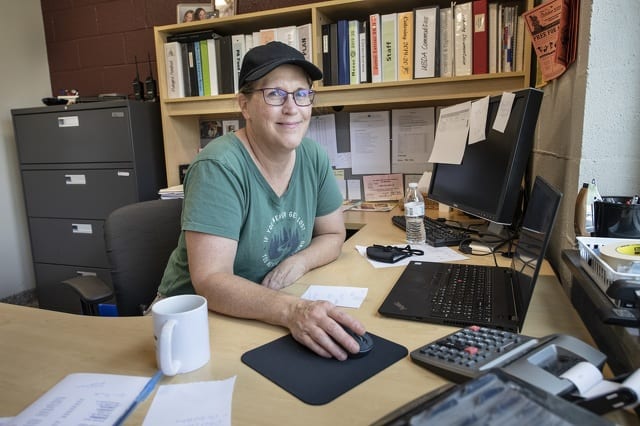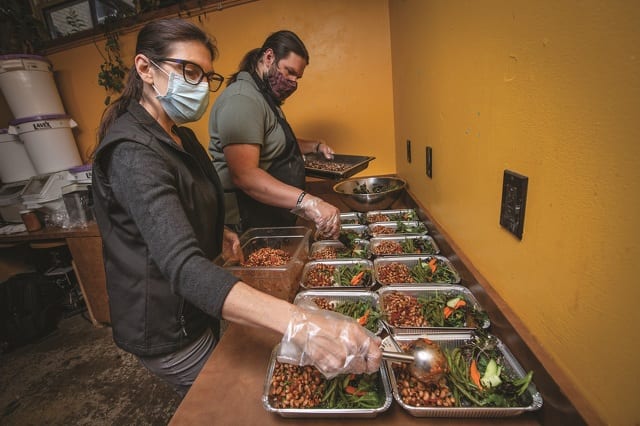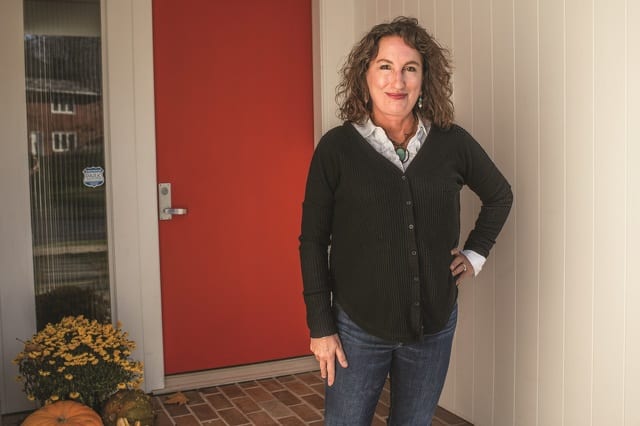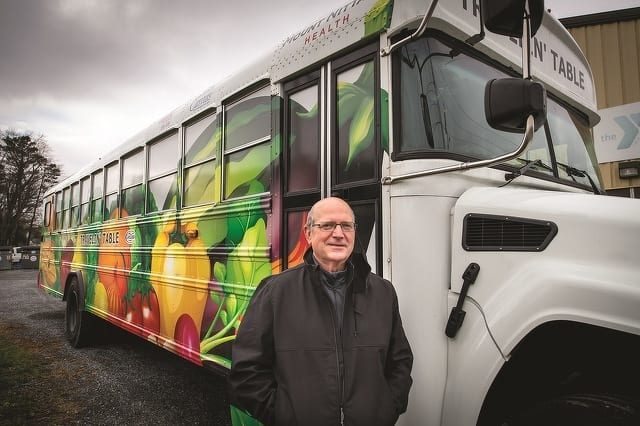In an extraordinarily difficult year, we found kindness in every corner in Centre County. Town&Gown’s ‘Neighbor to Neighbor’ series explores some of those stories.
Even in “normal” times, most Americans, including Centre Countians, would likely be shocked to know just how many of their neighbors are struggling with the invisible issue of food insecurity. But during a global pandemic that has led to business closings and layoffs, the numbers are absolutely staggering: One in four children. Forty percent of undergraduate students. More than 20,000 people in Centre County alone.
Fortunately, this community is blessed with organizations and individuals who focus on helping these neighbors, on scales ranging from massive county-wide undertakings to individual, grassroots campaigns. Some of these efforts have been around for a long time, but have been forced to expand in the wake of the coronavirus crisis. Others were started to fill a need during this challenging year. Here we present the stories of a few individuals who are passionately dedicated to providing their neighbors with some of life’s most basic needs.
Facing new levels of hunger
Mel Curtis, YMCA of Centre County
Mel Curtis and his massive anti-hunger efforts at the YMCA of Centre County have won accolades from national organizations such as Feeding America. But that recognition really only matters to Curtis if it helps to get the word out about the issue of hunger and food insecurity.
“I probably spend 75 to 80 percent of my time educating the public that yes, there is an issue,” Curtis says. “There’s no bling to hunger, at all. No one likes to talk about it. There’s no face to hunger, no address. You can walk down College Avenue this afternoon, and say you pass 100 people, you can’t tell which of those people are facing food insecurity. They’re not carrying a sign. That’s the hard part about hunger.”
The anti-hunger program that Curtis directs basically has two arms. One is the general food distribution arm, that focuses on getting food into the hands of families, the elderly, college students, and anyone else experiencing food insecurity. The other focuses on children, ensuring they have enough food to get them through the periods they are not in school, through both a weekend Backpack Program and a USDA-funded summer lunch program.
The reach of the YMCA’s anti-hunger program extends to the farthest corners of Centre County, which Curtis points out covers more square miles than the entire state of Rhode Island, as well as into parts of Clearfield County. The local need has always been great, Curtis says, but in 2020 it is reaching new, almost unheard of, levels.
“By the end of October, we had already put out over 1.1 million pounds – that’s 589 tons – of food,” he says. “We have not seen anything like this, not even close to this, since the Great Recession. These numbers are absolutely crazy.”
For example, Curtis says, on a recent day, he coordinated one food distribution for 280 people during the day, followed by another distribution for 319 people that evening.
“Then we did one in Wingate, and I about fell out of my chair when I saw the numbers – upwards of 400 people,” he says.
“It used to be very, very hard to find people in need. That used to be one of our biggest challenges. People are often too proud to accept help, or else they’re in situations where they don’t want people to think they can’t take care of their children,” he says. “Now, it is not very hard. Now, they’re calling us. They’re realizing they’re not going to get called back to work, they’ve used up a lot of their savings, and they’re a little bit more comfortable coming to seek food at our food distributions.”
Curtis works out of the Moshannon Valley YMCA, where he has been the branch director for 23 years. Here, two tractor-trailers (one serving as a freezer, and one as a refrigerator) and a 5,000-square-foot facility – formerly an indoor baseball complex – are filled to the brim with food. Some of the food is provided through various USDA programs, but much of it is dependent upon local donations. The Backpack Program in particular heavily relies on financial donations.
Curtis started the Backpack Program six years ago. Through this program, at-risk students in eight local school districts are provided backpacks full of food each week to ensure they have enough to eat over the weekend. Food is purchased from Sam’s Club so that every backpack is filled with identical items. The program costs about $150,000 to run each year.
In a normal school year, Curtis says, the program provides 1,300 backpacks each week. This year, they are providing about 800 backpacks. The reduced number is not because there is less need, however, but more because many families have opted to do virtual learning or are not attending school in-person for various reasons.
Curtis says when the schools shut down in March, feeding the kids was his first priority.
“On the day the schools announced they were closing down on March 15, we were immediately out feeding kids. We were fortunate we had food available because of our Backpack Program, so we were able to get food into these kids’ hands as quickly as possible. We’re also very fortunate that, because schools were closed, we got a tremendous amount of volunteers from the schools – teachers that have a strong interest in wanting to make sure their kids are doing OK.”
Curtis runs the YMCA’s vast anti-hunger operation almost single-handedly, so volunteers are crucial. As of October 31, more than 300 volunteers had logged almost 13,000 hours.
“I have one part-time person who works in my food warehouse. I’ll grab some of my [YMCA] staff when they have any extra time to help me out. Other than that, it’s all volunteers,” he says. “It’s seven days a week. It’s a lot of sleepless nights.”
Curtis has been known to get creative in trying to increase the program’s reach. For example, this summer, in an attempt to attract kids in low-income areas, he enlisted the help of volunteer fire companies.
“We loaded up the trucks with pizza and juice and started driving through all these areas, and kids came running, because kids love fire trucks,” he explains. That experience led him to purchase a fire truck for the program.
“I’m kind of a gunslinger, because if I see an idea, I jump at it immediately and beg for forgiveness afterward,” he chuckles. “But CEO Scott Mitchell has been phenomenal, and the Y has totally embraced this program.”
Curtis believes the number of people of all ages facing food insecurity in Centre County is going to continue to grow. In addition to the five food distributions they are averaging per week, the YMCA anti-hunger program recently donated food to Penn State’s Lion’s Pantry for college students in need, provided Thanksgiving meals to 250 families, hosted a “Farmers to Families” distribution, held milk and frozen chicken drives, and is currently working on packing Winter Boxes containing a week’s worth of food for local families.
Curtis says the program is always looking for more volunteers, and they make it as safe as possible during the pandemic.
“When we bring people in to do things, we limit numbers to six or eight people, and we’re abiding by CDC guidelines. Everyone is masked-up,” he says. “Even if you can only give one or two hours, that’s everything. Anything a person does for us is impacting a person or a family in Centre County.”
Curtis encourages anyone who would like to volunteer to contact him directly at mcurtis@ymcaocc.org. To donate, visit ymcaocc.org, or send a check to YMCA of Centre County, 125 West High Street, Bellefonte, PA 16823.
Nutrition and connection beyond school walls
Megan Schaper, SCASD Food Services
“If the schools close down, how can I continue to feed kids?”
That was Megan Schaper’s first thought when the pandemic hit in March and SCASD started discussing the possibility of school closures.
Schaper, the food service director for SCASD, was thinking about her free-lunch-program students, who rely on the breakfasts and lunches provided by the schools every day. Apparently, she was ahead of the game, because when she called the Pennsylvania Department of Education to voice this concern, the department told her she represented the first school district to ask the question.
“I give the Pennsylvania Department of Education high marks, and I give the federal government high marks,” she says. “They all worked very, very quickly to come up with solutions.”
Those solutions included making the USDA-funded free meal program universal, and tweaking the summer lunch program to allow it to be offered for the entire school year, while waiving some of its usual requirements.
During the first couple of weeks of school closures, Schaper and her staff experimented with different means of distribution as their efforts evolved.
“At first, we were going out into low-income housing developments and handing out a breakfast and a lunch every day. I had initially projected we would be doing 200 meals a day, and very quickly we were doing 500 meals a day,” she says.
Soon the USDA provided a waiver to allow school districts to hand out a week’s worth of food at a time and no longer requiring students to eat the meals on the premises. These were welcome changes, because they meant less potential coronavirus exposure for volunteers and for families picking up meals.
“We moved to the weekly meals, and once we did it made it so much more convenient for families to pick up. So, very quickly we went from 500 meals to 1,200 bags. Each bag contained five breakfasts and five lunches, so when I say we were handing out 1,200 bags, that was actually 12,000 meals.”

Led by Megan Schaper, State College Area School District food service employees, as well as teachers and custodians who volunteer their time, have helped the district’s food distribution operation run like a well-oiled machine. Photo by Darren Andrew Weimert
Meals were distributed on Wednesdays in the parking lot of the State College Area High School campus. At first, Schaper says she had reservations about the amount of traffic the site could handle, so she capped the amount of bags at 800, “but the first week went beautifully, so that was the only week we ever restricted anybody.”
Staffed by food service employees as well as teachers and custodians who volunteered their time, the operation was soon running like a well-oiled machine. At its peak, it served more than 3,200 bags, or 32,000 meals, during a week in September when schools temporarily shut down after reopening in August. Wednesday distributions continue even when the schools are in session in order to reach the families who have opted for virtual or remote learning options, as well as for families with preschool children or children who do not otherwise attend a school with a USDA meal program, currently averaging about 925 bags per week. As of early November, the program had provided more than 350,000 meals outside of school walls since March.
The program, which is funded by the USDA, has many benefits, Schaper says.
“USDA put this out there first and foremost as a support for kids and families to make sure they had adequate access to food. But it has the added benefit of being able to help food service employees stay employed,” she explains. “And then, I’m able to continue to purchase supplies from my vendors. So it ultimately ends up serving as an economic driver for our whole community.”
The free lunch program has also been expanded and changed to have the maximum beneficial impact on children. Schaper explains that during a normal school year, the free lunch program provides breakfast and lunch during school hours for either no cost, or a reduced cost, to children whose families demonstrate financial need. Under the 2020 temporary guidelines, the USDA has made the free breakfasts and lunches available to every student, regardless of financial eligibility. In addition, middle school and high school students who are in school only every other day due to the current schedule can pick up bags of food to take home for the following day, Schaper says.
The universal free meal concept is an idea Schaper has been advocating for a long time.
“I think an important part of a school lunch program is teaching kids how to eat well. When you also have to sell that meal to a child, it’s a little bit harder. A universal program where meals are free would in theory give us a little more room for pushing the boundaries of getting kids to try things that they might be less likely to. So I’ve been looking for universal free meals for forever. But I never anticipated it would be in this context.”
Schaper, who has been the food services director since 1993, feels school meals fill another need that goes beyond nutrition, because they help to create an important connection with the students.
“I have always thought some of the finest people working in school buildings were the child nutrition staff. There is nobody else in the building that knows every child’s name. But my staff does,” she says. “A silver lining that’s come out of all of this is I think the community really has come to appreciate the work that those people do. We have received such really lovely, heartfelt messages. … Many of them say that when their child is learning at home and they are feeling disconnected from their school community right now, the fact that they can get a school meal and eat it at home helps build some of that connection back.”
Families, including those with preschoolers or with children who do not attend a SCASD school, can order meals by visiting scasd.org/ordermeals. The public can help SCASD families by donating through the SCASD Foundation at scasdfoundation.org.
Serving community meals with respect and love
Elaine Meder-Wilgus, Webster’s Bookstore Café
Webster’s Bookstore Café in downtown State College has become a safe haven for many locals over the years. From hosting and supporting LGBTQA events and causes, to selling organic and fair trade coffee and tea, and serving gluten-free and vegan meals, owner Elaine Meder-Wilgus has set out to create an inclusive environment for all. So when the pandemic hit, Meder-Wilgus grew concerned about her Webster’s family.
“Back in April, it became very clear to me that my regular customers were mostly in the high-risk groups due to any number of circumstances, but they were kind of grieving the ability to see us. So we came up with this curbside pickup, and thought about how we could extend it to people that had food security issues,” she says. “It’s always something we’re thinking about here. I was a single mom for many years, and it’s just always on my mind – the challenges for people who are doing OK, but could be doing better, if they just had a little bit of reminder that they matter.”
So, Meder-Wilgus and her current staff of five (during normal times she has 16 staff members, she says) decided to offer locally-sourced vegan and gluten-free community meals on Wednesdays, provided for free to anyone in need, or for $10 for those who wish to pay. Each $10 fee helps to pay for two additional donated meals, she says. Webster’s feeds approximately 100 people each week, and donates any leftovers to the Community Café at St. Andrews Episcopal Church for its free community meals on Thursdays.
Meder-Wilgus reaches out to the homeless population and says she has customers who purchase meals for different people each week. Those people often turn into regulars, she says. No matter the circumstance, Meder-Wilgus says Webster’s staff treats all customers with respect.
“Everybody here is really committed to this idea that when you pick up a meal, the person giving you your meal has no idea whether you paid for it or not,” she says. “This is just one small way that we’re reminding people that we’re all in this together. And this is what we know to do.”

“This is just one small way that we’re reminding people that we’re all in this together. And this is what we know to do,” says Webster’s Bookstore Cafe owner Elaine Meder-Wilgus, preparing meals with Matthew Stullken. Photo by Darren Andrew Weimert.
Beyond helping those in need, Meder-Wilgus says the community meals serve a secondary purpose.
“I myself follow a vegan diet, and I want to expose as many people as I can to how delicious and filling and beautiful and clean it is to eat that way,” she says.
Webster’s currently offers seating for about 18 people, down from its usual 85 seats, and Meder-Wilgus encourages customers to do curbside pickup for safety reasons.
Meals are offered from 11 a.m. to 2 p.m. and 4-6 p.m. on Wednesdays. The meals are different each week. Menus are posted on the Webster’s Facebook page on Mondays, and meals can be pre-ordered at webstersbooksandcafe.com, although it is not necessary to pre-order. Customers can donate meals through the same website.
“The response from the community has been just wonderful,” she says. “I’ve had individuals step up and offer to essentially support a whole week of food for people. Lots of people donate three to 12 meals through our website. It reminds me of how much people really do care.”
Grassroots giving
Michelle DiMidio, The Alliance for G.O.O.D.
It’s been almost 20 years since Michelle DiMidio was a struggling single mother of three. That may seem like a lifetime ago, but DiMidio has never forgotten what it felt like to need help, and what it felt like to receive it.
“Back when I was a single mom, I was barely making ends meet. For a year, I had full custody of my kids but my ex wasn’t giving me any financial support. So it was a really hard time,” she says. “During that time, though, people were really generous. I would be teaching a class at East Coast Health & Fitness and someone would quietly flip me a gift card to the grocery store. Or I had a personal training client that noticed I needed a coat, and brought me one. That kind of stuff kept happening over and over again.”
This, she says, was the inspiration behind The Alliance for G.O.O.D. (Giving Others Our Donation), a grassroots effort she founded in April.
“Right after the quarantine started and it got really crazy, I was feeling like I was in a big funk. I just felt like I needed to do something to help, but I had no idea what that would look like,” she says.
Then, while listening to a podcast, she heard author Glennon Doyle say, ‘It is better to be done than to be perfect.’
“That was kind of hard for me because I like everything to be perfect. But I realized that my reluctance to help stemmed in part because I wanted to make sure it was the perfect way to help,” she says. So she decided to stop mulling things over and to throw out some feelers to her contacts to see if she could find support for some of the ideas she had swirling around in her head.
As a longtime volunteer for the Salvation Army’s Angel Tree program, DiMidio had a lot of contacts to whom she could turn for feedback. For almost 10 years, she helped the State College Salvation Army fulfill Christmas wish lists for local families through her own network of friends and acquaintances. Her efforts grew to the point that she was named the Salvation Army’s local “Volunteer of the Year” in 2013. Recent structural changes to the Angel Tree program have drastically reduced the need for her services, she says, and she has missed having the opportunity to serve the community in this way, as have many of the people who helped her fulfill wishes each year.
So, she drafted an email to send to her contacts, in which she asked two questions: if anyone knew of any local individuals or families who were struggling, and if anyone would be willing to help fulfill their needs once they were identified. She hit “send” with a little bit of uncertainty.
“I thought, if no one responds, then I’ll know this is something that is not going to work,” she says. “But then I was overwhelmed with responses. People really wanted to do something.”
Through her inquiry, she was referred to Housing Transitions, and the first project of the Alliance for G.O.O.D. was to put together goody boxes filled with donated items like grocery gift cards, cloth face masks, non-perishable snacks, notepads and pens, and games. DiMidio used the SignUp Genius app to set up a system by which volunteers could sign up online to fulfill these specific needs. Once all of the items were collected, the goody boxes were delivered to Housing Transitions’ displaced homeless clients, who were being housed in hotel rooms when shelters were forced to close due to social-distancing recommendations.
Since then, DiMidio has helped to coordinate efforts to supplement the works of several other local nonprofit organizations, which, due to fundraising event cancellations and other pandemic-related hardships, may be lacking in money or other resources.

“I think we all felt kind of helpless at the beginning of this pandemic, and still do to some extent. The people on my team are so grateful to have the opportunity to do something,” says Michelle DiMidio, founder of The Alliance for G.O.O.D. Photo by Darren Andrew Weimert.
Her favorite thing to do, however, is to help individuals in need. The Alliance has helped to feed and clothe single mothers and their children, even providing services like tutoring and babysitting.
DiMidio estimates that her Alliance volunteers have so far donated more than $15,000 worth of gift cards, services, and items ranging from bicycles to televisions and even postage stamps. She prefers this grassroots method of giving to fulfill specific requests, which allows people to make their donations more personal.
“I don’t want to become a bank. I don’t want to just write checks. I like it to be more organic. I want to feel a change and be a part of the change,” she says. Having said that, however, DiMidio says she has been blown away by the generosity of the community, including people who just leave envelopes full of cash in her mail slot, telling her to use it to buy whatever the Alliance needs.
DiMidio encourages the public to contact her to let her know of individuals or organizations in need of assistance.
“I am very open to whatever the needs are,” she says.
DiMidio cites studies that show physical and mental benefits of giving, and believes Alliance for G.O.O.D. volunteers are almost as appreciative of the chance to help as the people on the receiving end.
“I think we all kind of felt kind of helpless at the beginning of this pandemic, and still do to some extent. The people on my team are so grateful to have the opportunity to do something,” she says. “It’s come full circle for me to be able to go from being a beneficiary of this community, to now be able to be a part of this community to affect change in the givers as well as in the ones who are receiving.”
To request help or to offer help, contact DiMidio at dimidio@gmail.com or visit the Alliance for G.O.O.D. Facebook page or website at: dimidio.wixsite.com/website.



